Pilgrimage: Great acting, beautiful vistas, questionable script [no spoilers] #richardarmitage
I recently had the opportunity to view Pilgrimage (2017) three times at the 2017 Tribeca Film Festival. Individual reactions from those nights are here, here and here. This is an attempt at a coherent evaluation of the film, but if you read those posts, this won’t surprise you much. This post is intentionally spoiler-free; a more extensive review with spoilers that might give a better idea of the specific reasons for my mixed feelings — but also the things that I found intriguing about it — will follow soon.
***
Director Brendan Muldowney’s film, Pilgrimage, tells the story of a group of thirteenth-century Irish monks who traverse a corner of Ireland to take ship and bring a powerful relic to Rome in the immediate wake of the 1209. The visually engulfing story centers on the perceptions and reactions of Diarmuid, a young monk, as he observes both his traveling companions and the world and manners outside the monastery. A journey that is supposed to take four days is complicated by language difficulties, cultural conflicts, and a great deal of violence from various groups, most notably the Ua Mordha, a local clan whose members follow pagan customs, and the Norman overlords of the area, who after two centuries of attempts at colonization still wrestle for sovereignty in the constellation of pope, French king, and local politics. Shifting allegiances and unexpected events complicate the monks’ journey significantly, and saying anything more than that about the plot would probably be saying too much.
The ninety-minute film takes up some common cinematic tropes, such as Diarmuid’s metaphorical end of innocence, the nature of religious belief and doubt, particularly as these concern the supernatural, and the motif of the journey with companions, unfortunately jumbling them together in ways that are not particularly intelligible, skillful, or interesting. Unfortunately, it’s hard to see the script for this film (written by Jamie Hannigan) as anything other than a muddled mess. One of these themes might have been successfully explored in ninety minutes, but not three. And in such a short film — and one in which one of the major characters is silent and the rest of them don’t have a shared mutual language — every line of dialogue must be used to maximum effect. But the film seems almost dazzled by its marvelous landscapes into meandering, particularly at the very beginning of the film. The script squanders its first, best chance to set the mood by wasting a scene on a dialogue with no relevance to the remainder of the film.
More gravely, given the importance of philosophical and psychological questions to the main themes of the film, the script often leaves us asking questions that can’t be answered without information external to it. Repeatedly, the characters’ motivation is left either untouched or intentionally confused — no more worse than in the case of two of the four most central characters, Jon Bernthal’s “Mute” and Richard Armitage’s Raymond de Merville. The “Mute” has a mysterious past that is supposed to explain his behavior, but we are left to judge him only by his behavior, which is frequently confusing. The only explanations I could think of were one-sided or superficial. The same for Raymond de Merville, whose actions are inconsistent given the motives he states for them. The only character that gets a real back story is Frere Geraldus (Stanley Weber) and he doesn’t get it until the last fifteen minutes of the film; I found this “just in time” motivation supply awkward, not least because better plot organization would have allowed us to contrast the parallel positions of the two great opponents of the film — Raymond and Geraldus — a relationship that is obscured through this delayed, cheap style of storytelling. It’s as if someone reminded Hannigan at the last second that he needed some explanation — since it is not supplied organically or developmentally.
When the script does allow us to see something of character development, however, it is abrupt and unconvincing, as in the case of Diarmuid. The ending of the film is bizarre; no doubt some people will find it profound or edgy, but I found it sophomoric. It defangs the motif of “journey as self-recognition” by removing all the danger and commitment from the narrative. Significantly for me, anyway, is that it is the most unmedieval ending to the story that I could have imagined. This is perhaps not surprising, as the film is filled with religious anachronisms and clichés that will prevent it from being very interesting for one of its core audiences — people with serious interests in medieval history. Admittedly, I am perhaps over-occupied with this issue in comparison to the average viewer of the film, but really, it was the only thing about the film that interested me intellectually, and it was a disappointment.
In themselves, the repeated errors and anachronisms might not be bad, if one had the impression they were more than simply laziness. “Rewriting history” can allow a script to address modern philosophical questions about faith and religion on the pre-modern past, a technique used effectively if somewhat stereotypically in Martin Scorsese’s recent film, Silence (2016), an uneven adaptation of the masterful twentieth-century novel by Shusaku Endo. That’s not what happens here, and the script seems to lack fundamental awareness of the religious landscape of the thirteenth century, beginning with its aggressive assertion in the first minutes of the film that, in 1209, “Christianity dominated Europe.” (True, if we leave out Spain, large parts of France, all of Scandinavia outside the cities, and most of the eastern part of the continent, along with rural areas in general.) If you don’t already know why 1209 was an important year in the history of Christianity, the film certainly won’t tell you, which makes all the extra work of locating it in the middle ages, particularly with the language diversity (which I admittedly enjoyed) largely superfluous. The script doesn’t really understand the status of Irish monasticism within western Christianity, or the relationship between the persistent pagan elements in the Irish landscape and the “dominance” of Christianity in the film’s contemporary present. I suspect most viewers will not leave this film thinking that “Christianity dominated Europe.”
The film makes fundamental errors about medieval Christianity, so that given the issues with the characters’ backgrounds, the moral dilemmas that it may try to be speaking to are not only foreign to the middle ages, they make little sense as such. It’s a problem in the case of Raymond in particular, because if we believe the things he says about why he does what he does, the acts themselves become hard to credit, if not implausible. (I will explain this assertion in detail in a separate review.) The script is ignorant of how doubt or relic piety actually worked in the middle ages and for that reason it is impossible for Hannigan to say anything meaningful about how they work in the present. The result is a film that often makes medieval people look either naive or idiotic or ignorant of the natural world. They were none of these. Occasionally I wondered if Hannigan were trying to say something about modern fundamentalism.
The violence level of the film has been widely mentioned, and prospective audience members will have to determine their own tolerance levels. It will certainly receive an R rating in the U.S. Pilgrimage unfortunately succumbs to the idea, prevalent in modern films, that violence is primarily the result of power differential and that medieval people were violent to each other for any reason at the drop of a hat. The film very much endorses the idea of violence as spectacle, and that in itself is not alien to the middle ages, but the spectacle it presents to us is troublingly uniform, conflating judicial violence (responses to crime), extrajudicial violence (violence as crime), religious violence (committed for G-d), self-defense, and political violence (in war or for political gain). The film is one wild sea of gore: people who enjoy that sort of thing will definitely get their money’s worth in this film. Admittedly, I am not one of them; but it’s probably true that the sheer number of crimes committed against the human body in this film distracts from the film’s historical and religious stumbles. At the same time, the performative quality of much of it suggests that the filmmakers spent more time focusing on equipping the characters with period-appropriate weapons than with period-appropriate attitudes and experiences.
If the film is worth seeing, then for two reasons — first, the marvelous landscapes of Ireland and Belgium that cinematographer Tom Comerford shows us. I’ve never been particularly interested in visiting Ireland, but the coast that we see in this film provides an intriguing contrast to much of the “green” that the Irish tourist board exploits in its U.S. advertising campaigns. I should also not neglect to mention the equally atmospheric score by Stephen McKeown, which hits a lot of the clichés of pseudo-medieval orchestration (I would like not to be reminded of Carmina Burana occasionally when watching one of these films), and is occasionally a bit heavy on the symbolism of the clang noise, but which impresses and enhances the film overall.
The second is the high standard of acting. The film has not one single weak or implausible performance. Most attention naturally falls on Tom Holland, who is the “eyes” of the journey and from whose perspective we are meant to see much of what happened. Holland has a facial habitus that is only partly transparent; at times we know what he is thinking, at other times we do not; and he occupies the uncertain cusp that his character dances on between child and man (keeping in mind that the middle ages did not have adolescence as a life stage) with bravura. Jon Bernthal has the hardest job, both as he has no words to explain himself, but also as the script only allows us to speculate about the sudden transformation that occurs halfway through the film and his snap decision at the end. His expressiveness, but also his guardedness, jostle with each other and he does a masterful job of showing the dilemmas he experiences between loyalty to the lessons of his shrouded past and the concrete demands of his present. Hugh O’Conor and Rúaidhrí Conroy seem most like what I would expect Irish monks to be. Stanley Weber also works astride an interesting conflict in his character between piety and an (anachronistic — but this is what the script demands of him) attitude that is almost like Realpolitik. But my favorite performance among the monks was probably that of John Lynch as Brother Ciaran. His brooding, wise, sad, and finally tortured presence knits the monks together as a group and provides the necessary perspective on all the different notions of religiosity that the film brings to bear.
Fans of Richard Armitage who can tolerate the violence should also love this film. Armitage does a lot with a confusing character who shows basically no development at all during the film — in particular packing enough into Raymond de Merville’s final speech that at least his motivation becomes more plausible. Given a role that is the dramatic equivalent of treading water, Armitage does an amazing amount with his eyes, showing an internality that reacts with his outer actions. It’s as if he’s observing himself act and judging himself as actor at the same time — and it’s this internal quality that he gives to the character that makes some of the more stereotypical moments of the role bearable to watch. As Raymond, Armitage demonstrates yet again that he can do more with his eyes and his jaw than most men can do with their entire bodies. His gait and his posture, too, emphasize the inner status conflicts the character experiences as heir of a powerful man, who can at present only agitate behind the scenes.
Armitage’s Raymond commits numerous violent acts. On one level this is nothing new for us as audience members; Armitage has played soldiers, spies, murderers, serial killers, and although it is now often forgotten, once upon a time it was a prominent piece of his biography that he’d studied for a qualification in stage fighting. But Raymond is among the most unapologetically brutal of the characters Armitage has played — perhaps because we know so little about his background and Armitage does little to make him sympathetic. His dance background also helps him here, but Armitage’s dance this time, particularly in the closing scenes, is one of raucous, delighted belligerence. There’s nothing pro forma or held back about the glee with which he kicks his victims or slaps his palm with his mace; he only stops short of licking his lips. Both Raymond and the Mute are men made by, and for, war — but it’s Raymond who seethes with aggression and explodes out of brooding watchfulness and obligatory piety to watch, with delight, the physical anguish and organizational havoc his violence causes.
And I suspect most Anglophones will find the accent a plus.
In the end, the film is at best a mixed success — the script needed a script consultant and rewrites from at least two angles (I will explore these in my longer, spoilery review) and the story was not plausible to me either as a former church historian or as a student of human nature. But the amazingly atmospheric quality of the pictures and the consistently effective performances redeemed it for me. It should definitely find an audience but, I suspect, predominantly among fans of action / adventure films and of the actors involved.

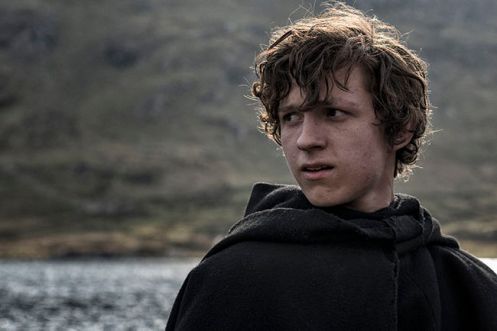
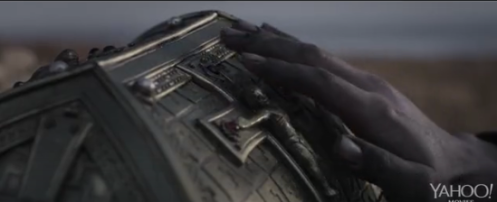



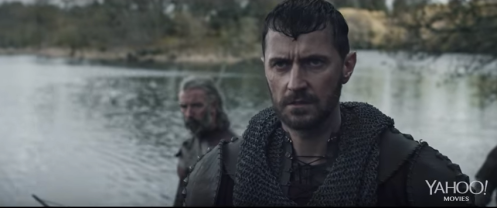
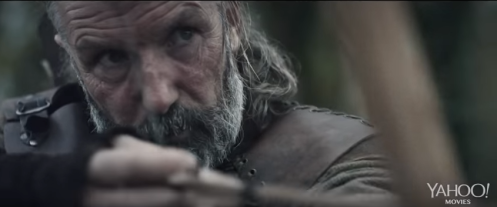
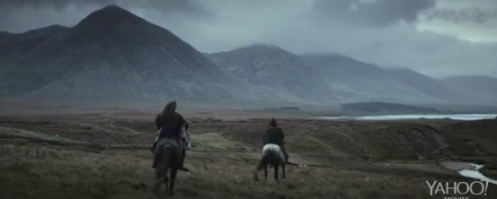



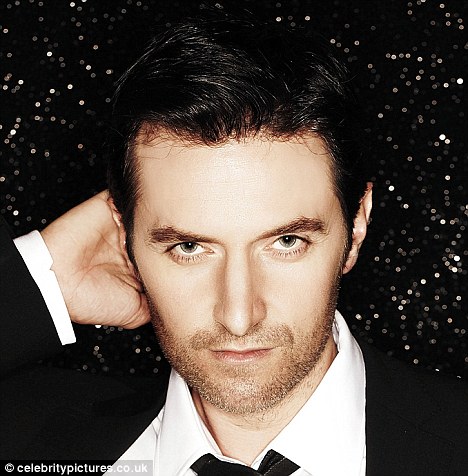


🙂 Amazed by this full flight on top of this movie’s review. Thank you!
LikeLike
I would like to hear him talk about his choice as an actor, for such a violent role (intrinsically, in his own nature), to what he wants to initiate, to guide, to bring , to educate his fans?
LikeLike
I could be wrong, of course, but I suspect the decision for this role wasn’t really about the attraction of the role but rather out of various professional considerations. Hopefully he will say something about that during the publicity for the general release.
LikeLike
According to Dominique Moïsi, in his book “Geopolitic of the series”, there are 2 schools to explain the violence in the current cinema. The realistic school: course of cynicism or the ethical school: morality classes.
LikeLike
This is interesting. I’m not an expert on the history of violence by any means but most scholarship emphasizes that violence has an internal logic and morality. It’s not ever arbitrary.
LikeLike
Yup. We agree here that the one weakness in the film is the script, itself. Based on the Q & A after the premiere, I honestly don’t think Hannigan or the director wanted to say anything special – or maybe they’re just lousy public speakers, but their explanation of how this film came to be seemed to me very random and without much thought. But, I think the film will find its audience and make back its funding. Looking forward to the spoilery review.
LikeLike
I still haven’t read anything or looked at anything. It seemed from how the movie was sold that they didn’t have a script going into the sale — that Hannigan wrote it afterward? I think you’re correct that it will make its funding, even in arthouses.
LikeLike
Thank you for your detailed but spoiler-free review. Sure, it’s a pity that the script seems to be weak and many plot lines are not fully explained but hopefully the beautiful landscapes and the good actors will compensate this deficits. At least, the movie differs from the vast majority of upcoming flicks related to the Marvel universe or the tenth sequel of something and treats an original theme.
I am also convinced that the target audience (not necessarily Armitage fans) won’t be overly surprised by the violence since the Middle Ages in the movies are mostly depicted as brutal, archaic and merciless.
LikeLike
I guess the issue for me is that this isn’t a huge blockbuster and it was never designed to be. If a mass market movie tells a ridiculous story about history (like basically every Robin Hood film does), well, that’s one thing — it’s directed at a mass audience. But this was an indie and films like that tend to attract different audiences — i.e., myself, I wouldn’t go see the latest Paramount version of Robin Hood but I would see this. So the demands of genre are different. That said, as Perry said I assume this will find its level.
re: violence in the MA — I think the film mostly escapes this problem in so far as a lot of the violence occurs in battles / self-defense and the reason for those conflicts is obvious and plausible. It’s the other stuff (maybe about a third of the violence) that is problematic. But violence is always culturally and historically conditioned; what we don’t understand seems cruel to us even as we do unspeakable things. The Aztecs were horrified that the Spaniards would torture someone publicly by holding him above a fire — a civilization that itself repeatedly engaged in public, live human sacrifice. Europeans are horrified by US methods of capital punishment but the majority of people here are not bothered enough by them to put a stop to them.
LikeLike
The point is that not every indie tells a coherent and plausible story, neither is there always an absence of unnecessary cruelty.
Perhaps the typical audience for indie films expects too much and is easier disappointed afterwards.
Maybe it is only a question of money and they couldn’t afford a better writer…
LikeLike
I don’t think it’s expecting too much for any film to meet certain expectations, like, for example, historical accuracy or plausible script. That said, we’ve relegated those expectations to the realm of the art house audience as apparently we absolutely cannot put any of the traditional expectations for films on the mass audience for Marvel-style superhero films. (which isn’t to say they are all bad, they’re not, but so many of them are, and they waste so much money being bad.) I don’t think it’s a bad thing to have high expectations of art, myself. (In practice, I think most people have varying levels of expectation depending on context.)
Hannigan doesn’t have much of a track record. But the thing is — even if you didn’t understand something like (say) relic piety very well, and I agree it’s a complex topic, the film makes a lot of errors that they could have fixed with a 30 second google. E.g., what did a papal bull / charter / letter actually look like? If I were a filmmaker, I’d look that up.
I agree that money must have played a role here, though.
LikeLike
Of course, it’ s not a bad thing to have high expectations of upcoming movies, whether they are independent films or so-called blockbusters. I am usually disappointed about films with a beloved literary template, but can’t help to watch them. On rare occasions I am positively surprised about the realization. ‘Lord of the Rings’ is one good example.
LikeLike
Yep, curious to see this, despite flawed script!
LikeLike
I was glad I went.
LikeLiked by 1 person
Considering the writer bragged about his research i am disappointed.
LikeLike
The success of research is typically based on how good the questions are / what the questions are that one asks. If you don’t ask the right questions, you won’t get the result you need.
LikeLike
Thanks for this review! I won’t have a chance to see the film until it becomes available in Europe or online but I’m still looking forward to the spoilery review because even though the storytelling seems weak I’m still interested in the film. as for re: “[…] spent more time focusing on equipping the characters with period-appropriate weapons than with period-appropriate attitudes and experiences” – I can’t say much about the weapons from the few glimpses I got to see from the trailer but the armour makes me cringe: fantasy orc-style studded leather pauldrons – really?? and the chainmail coif they put around RA’s neck offers no protection whatsoever when worn like this without a protective collar underneath, just dangling around leaving his throat and the back of his neck completely exposed, probably getting in the way, uselessly weighing him down (if it was actually made of steel rings…) also it would offer very little protection to wear the chainmail hauberk just over a normal tunic instead of a padded gambeson. I can see why they might want to leave out this protective layer in films because it would make the actors look very bulky and also it can get quite hot underneath all the wool-padding, but still it would be nice if there was more attention to authenticity in films and series sigh And (replicated) early medieval clothing is actually quite comfortable to wear – so it would not be more bothersome for the actors or anything… All filmmakers planning to tackle a medieval setting should be obliged to watch the Swedish film trilogy “Arn” (https://www.youtube.com/watch?v=KkqXXKb0jrA) first – they got really nice authentic armour, the appropriate breeds of horses for the different regions, film-swords that were actually hand-forged by master-swordsmiths and so on…but of course the book was better, even in this case 😉
LikeLiked by 1 person
Wow, thanks for the EXTREMELY interesting comment! I don’t know anything about the weapons — but they are very elaborate and one sees a lot of them, so I assumed they had put a lot of time into thinking about them. This is a really enlightening bunch of detail you provide.
LikeLiked by 1 person
Yes good remarks!
I send some pictures to my son’s Weapon master. He is passionate of artistic fencing with medieval and “renaissance” performance, they practise reenactment of fights.
LikeLike
Thanks for the detailed review – despite the gore I liked it. Very interesting comment about the weapons and armour from Anja above. I’m interested in your thoughts on Armitage’s performance, both here and in previous posts. You see a depth to his acting that I am having difficulty perceiving … I just see the same expressions, posturing in everything he does and I would like to see him do something completely different. I guess I’m being harsh. Maybe I need to see him on stage to appreciate his acting a little more. There was a time when I watched every role with a sense of wonder at the emotion he could portray – I’m trying to find that enthusiasm again, sad to say. I’ll look forward to reading your post about the violent roles (if I can find it again) … I keep getting lost in your blog 🙂
LikeLiked by 1 person
There’s one scene that I think is fairly unique in his work; it’s a twist on things he’s done before, but it’s different, mostly because he really succeeds in not telling us what’s in his mind. I’m thinking of the one in the pagan camp with Br. Ciaran.
I didn’t write about the violence because I didn’t feel like digging for my notes from grad school, but the upshot is basically that the middle ages were not violent in this way — this is a myth sold ot us by Mel Gibson and Game of Thrones. There were very strong boundaries for violence. People didn’t just attack people they met randomly on the road; criminals weren’t simply summarily lamed by their lords. (Apparently the weapons are also all wrong for the period, but I don’t know anything about that.) It’s a bit like our lives today — the US is actually a very violent place but there are rules around the violence. It’s not arbitrary. This film makes it seems arbitrary, and that depiction — apparently in the service of an audience that lusts for and is turned on by gore — is inaccurate.
LikeLiked by 1 person
[…] of these, filming in late spring 2014 (the others were Sleepwalker in October / November 2014; Pilgrimage in mid-spring 2015, and Brain on Fire in August 2015). When this project was announced in March of […]
LikeLike
Richard Armitage in Urban and the Shed Crew, first reaction [some spoilers] | Me + Richard Armitage said this on April 9, 2018 at 8:38 am |